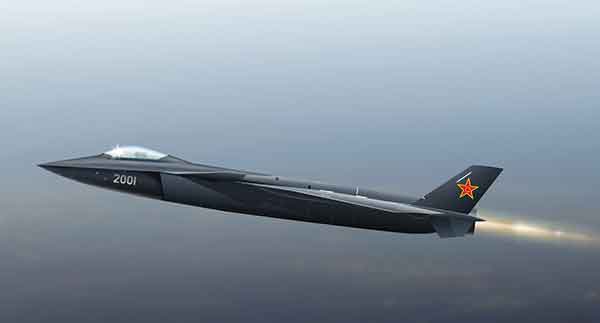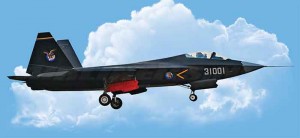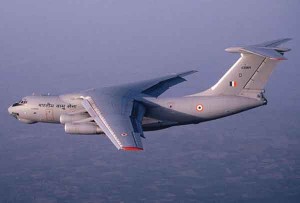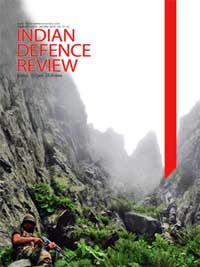The PLAAF has evolved from a territorial air defence force to one of offensive and defensive power projection beyond borders. It has also downsized by 40 per cent from the 1990s in terms of manpower and inventory. Its lethality and combat capability has, however, increased greatly with more qualified personnel, better training and replacement of Cold War era systems with latest generation weapons, some of them produced in-house by a defence industry transformed from licensed production to reverse engineering to one with original design and development capability.
The PLAAF has evolved from a territorial air defence force to one of offensive and defensive power projection beyond borders.
In terms of land area, the People’s Republic of China (PRC) is the fourth largest country in the world and the second largest country in Asia after the Asian part of Russia. It is also the most populous country on Earth. China has always aspired to be a major player in international affairs and other powers in Asia such as India, Japan and South Korea are seen as economic and military adversaries. The PRC’s relations with India are adversarial at the fundamental level since the Indian economy, political system and influence in Asia and the world are perceived to be in conflict with the former’s, notwithstanding the growing trade relations.
As per the latest Chinese Annual White Paper on Defence released on May 26, 2015, (http://news.xinhuanet.com/english/2015-05/26/c_134272293.htm), the PLAAF’s role has changed from ‘Territorial Air Defence’ to ‘Offense and Defence’ and that of the People’s Liberation Army Navy (PLAN) from ‘Offshore Defence’ to ‘Offshore Waters Defence and Open Seas Protection’. The thrust is on offensive operations, terming such operations a form of defence. Incursions into areas in the South China Sea, reclamation of land and construction of structures including airstrips and jetties is called ‘International obligations for development, disaster relief, search and rescue’ and protests by littoral nations like the Philippines are termed as ‘provocations’. All this points to a desire to establish Chinese hegemony beyond established borders.
Evolution
The PLAAF has evolved from a territorial air defence force to one of offensive and defensive power projection beyond borders. It has also downsized by 40 per cent from the 1990s in terms of manpower and inventory. Its lethality and combat capability has, however, increased greatly with more qualified personnel, better training and replacement of Cold War era systems with latest generation weapons, some of them produced in-house by a defence industry transformed from licensed production to reverse engineering to one with original design and development capability.
A build up in the MRs facing India could only be as preparation for offensive action against India territory.
The PLAAF was at its infancy in the Korean War in the early 1950s when confronting the USAF, with Soviet equipment, tactics and doctrine. The next phase was in the mid to late 1950s during confrontations with the Nationalist Chinese Forces over the Taiwan Straits. This was in fact the last significant air combat experience that the PLAAF has had till date. In both these scenarios, it fared badly against better trained adversaries employing innovative tactics.
The third phase was during the Vietnam War era followed by border conflicts with the Soviet Union and Vietnam. The People’s Liberation Army (PLA) came off second best in these conflicts. The PLAAF did not engage in any combat action in these encounters or during the Sino-Indian war of 1962. The Cultural Revolution disrupted the personnel structure and combat preparedness of the military and set back the process of modernisation by a few years.
The fourth phase extending to the present is one of downsizing of all arms of the military, modernisation of systems, greater emphasis on training, changes in doctrine, more independence to commanders and encouragement of innovative thinking, combined operations and developing of skills for amphibious, airborne and Special Operations as well as extended support to the PLAN by the PLAAF.
China already has an advanced electronic components manufacturing base…
Geography
China is divided into seven Military Regions (MRs). Each MR also has an Air Force. The regions are Beijing, Chengdu, Guangzhou, Jinan, Lanzhou, Nanjing and Shenyang. The Lanzhou MR covers North West Tibet. The Chengdu MR covers the Tibet Autonomous Region (TAR), a high altitude plateau and Sichuan, Yunnan and Guizhou. These two MRs are of particular interest to India since they are facing the Indo-Tibet, Arunachal Pradesh and the India-China-Myanmar tri-junction borders. The Nanjing MR that covers the industrial and economic heartland of China, faces Taiwan and a major maritime threat direction. The Shenyang and Beijing MRs face Russia and the Russian Far East, another potential threat area for China. The Guangzhou MR covers the coastal and maritime areas of Hainan, Hong Kong and Macau as well as industrial areas and is vulnerable to attack from the sea. Jinan MR is considered a strategic reserve.
It is, therefore, obvious that threat and terrain wise the concentration of force for defence would be in the coastal or Northern MRs. A build up in the MRs facing India could only be as preparation for offensive action against India territory.
Organisation
The PLAAF Headquarters controls all its own elements and the airborne forces consisting of the 15th Airborne Corps with 30,000 troops in organised in three divisions. Each MR has its own PLAAF assets. The military is PLA-centric but less so than a couple of decades ago. All MR Commanders are PLA officers. As for the organisation of field formations, a PLAAF Air Division has two or three Air Regiments. Each Regiment has two to three Flight Groups with eight to ten aircraft per Group. Each Group has two to three Flight Squadrons with two to four aircraft per Squadron. There are some independent Transport and Helicopter Regiments. Another variation is the existence of Air Brigades below the Divisions in certain areas.
PLAAF Equipment
The PLAAF has a mix of old and new platforms. Here only the major aircraft holdings are covered. Obsolete types in the inventory are disregarded and strengths are indicative.
Fighters/Reconnaissance
- 73 SU30 MKK Multi-role fighter, similar to but less capable than the SU30 MKI of the Indian Air Force (IAF).
- 75 SU27, precursor to the SU30.
- 24 Shenyang J16 twin-engine, multi-role fighter. Conceptually similar to the American F15, developed in 2013 from J11 airframe and reverse engineered SU30 MKK. More inductions likely.
- Over 200 Shenyang J11 A/B, twin-engine, multi-role, single-seat fighter based on SU27 airframe. Inducted in 1998.
- Over 250 Chengdu J10 A/B/C single-engine, multi-role, all-weather fighter in service since 2005. This aircraft is also in service with Pakistan Air Force (PAF) as FC-20. Derived from J-9 and probably with design inputs from Israel’s Lavi fighter.
- 144 fighter and 48 reece version of the Shenyang J8/F8 twin-engine interceptor. Introduced in 1980, it was based initially on the MiG-21 concept.
The PLAAF has always had more aircraft assets than the IAF…
Bombers/Tankers
- 120 Xian JH7 & 7A, two-seat twin-engine, all-weather, low-level, deep-strike bomber. Equipped with terrain-following radar, is also employed in anti-shipping role. In service since 2002. Airframe has some resemblance to the British Tornado and is similar in size to the F-4 American Phantom.
- Limited number of Xian H-6/H6K/H6 DU. Based on the twin-jet TU16 bomber, heavily modified as a tanker, in the H6K version as a cruise missile carrier and is nuclear weapons capable. The H6K entered service in 2009.
- Three IL-78s. Recent Tanker acquisition from Ukraine.
Stealth Fighters
- J-20. Under development as a longer range stealth fighter similar to the US F-22. Predicted induction is in 2018.
- J-31. Under development as a more agile stealth fighter compromising some stealth for agility. Similar to the US F35; predicted induction in 2017/18.
- J-18 VTOL. Rumors exist of development of a VTOL derivative of the J-31 for carrier operations with the prototype flown this year (2015).
Airborne Early Warning (AEW)
- Few KJ2000 and 3000. IL-76 (A50) based AEW aircraft in service.
- Two KJ 500. Shaanxi Y9 derived from the AN12.
- Seven KJ200 derived from the AN12. The PAF operates a variant called ZDK-03.
- 19 Y8 Electronic Warfare aircraft.
- Four TU154 M/D ELINT aircraft
Transport Aircraft
The transport fleet of the PLAAF consists of 16 IL76 MD heavy lift, 68 AN12-based Shaanxi Y8 (68), seven AN-12-based Y9 tactical transports, 40 Xian Y7 An24/26-based tactical transports, 30 Harbin Y11 and Y12 light twin-engine with STOL capability and few An2 utility aircraft of 1947 vintage. A four-engine turbojet, high-wing T-tail strategic heavy-lift transport, the Xian Y20 is under development with a prototype having flown in 2013. The aircraft has a 4,500-km range with a maximum payload of 66 tonne. It does not have advanced technologies incorporated in the US C-17 such as blown flaps and winglets as yet. Once developed, it is expected to enter quantity production.
The PLAAF has approximately 150 air bases. In India’s area of interest in Tibet, there are at least five large bases with 15 surrounding ones. About ten more are under construction.
Helicopters
The PLAAF has the Z18 and Z8 (versions of the Super Frelon) medium-lift helicopter, Z9 (license-built Eurocopter AS365), Mi8/17 and the Super Puma. In addition, the PLA has the Harbin Z/WZ 19 Reece & Attack tandem-seat gunship based on the Eurocopter Dauphin, introduced in 2012, with over 80 built, the Changhe Z11 Armed and Utility helicopter based on the Ecureuil, inducted in 1998 as also the WZ9 Armed Helicopter, with over 200 built (also exported to Pakistan). Over 250 Mi8/17 are held on the inventory along with 50 odd Z8, four Mi 26 Heavy Lift and 20 Sikorsky S70 helicopters. The WZ10 is the latest tandem-seat Attack Helicopter, designed by Kamov, entering service in 2012 with over 60 built. It is a modern aircraft similar to the Kamov Ka50. Pakistan has reportedly taken delivery of three with more on order. There are reports that its high altitude performance is not satisfactory. It is supposed to be inferior to the AH64 Apache in terms of weaponry and avionics. However, it is smaller, has a much better range and greater agility.
Aircraft Numbers
The PLAAF is estimated to have 20 Fighter, three Ground Attack, three Bomber and three Transport Divisions – in all 29 Divisions. In 1986, the figure was 50. The bulk of helicopter assets is with the PLA.
Another assessment gives the following figures of all aircraft assets held by all branches of the military:-
- Fighters/Interceptors 1,060
- Strike Aircraft 1,300
- Transports 870
- Utility Helicopters 900
- Attack Helicopters 200
The PLAAF has always had more aircraft assets than the IAF. The difference is that now a greater proportion of these assets are modern, fourth-generation fighters and all-weather helicopters capable of delivering Precision Guided Munitions (PGMs). These assets are supported by new-generation radars and force multipliers such as aerial tankers and AWACS.









Have you ready the article Attack Helicopters: Should India Have Them? If not please read. This a very good article. What is the solution to the problem? My surname also menon.
Read more at:
https://www.indiandefencereview.com/news/attack-helicopters-should-india-have-them/
IAF is doing just the opposit,
I
In 1971 war IAF had only 34 effective squadrons, each of which consisted of 12 planes . IAF had 16 air craft per combat squadron but the effective availability during the 1971 war was 12 per squadron. So in 1971 IAF had 408 effective planes. Now we have 582 effective fighter planes.
SU-30 MKI 224
Jaguar 145
MIg 27 85
Mig 29 89
Mirage 59
Total 582
In 1971 war IAF used two planes to conduct one sortie. Front plane is called front gunner and other plane is called rear gunner. Those days front gunners had to do so many operations at a time particularly at the time of dog fight. He had to chase the enemy plane and reach very close to the enemy plane to enable the correct hit. The range of fighter planes in those days were very limited particularly Gnat. So the front gunner had to keep a watch on fuel gauge even while chasing . The illumination of the dash board was so poor in Gnat that the pilots had to use torch. The main job of rear gunner is to warn the front gunner whenever he noticed another enemy plane attacking the front gunner. In one case the rear gunner could not give warning to front gunner due to communication failure . In another case a Gnat pilot had gone and landed in a Pakistan air field as the fuel was so low that the plane was likely to crash any moment. All these bottle necks have been taken care of in SU30 MKI and Tejas. Since SU30 MKI is being operated by two pilots there is no need for an extra plane to work as gunner during sortie. So SU30 MKI is equivalent for two planes Single plane is sufficient to conduct sorties by using AWACS. .So why do we require Rafael plane?
India never had strategic Military sense or any conception of Air and Sea Power. Indeed India’s leadership have done their best to destroy such thinking as it interferes with their agendas that engineer India’s national suicide. Lost, for more than Seventy Years, in looting, plundering and raping the unfortunates Indian Citizens that they now had power over, India’s Kleptocracy has never looked over its shoulders despite repeated shocks from both China and Pakistan, both of whom should have been insignificant adversaries who were put definitively in their places a long time ago when India was far more powerful than they . China has not geared up for India. It has geared up to take on the US if it interferes with China’s plans. India is now one of several tethered lambs awaiting the visitation of the tiger. China wants to endure that the US in the machan dare not fire.
China is not going to attack India. Their plan is very clear. They want to re- capture Taiwan. It is a part of China..